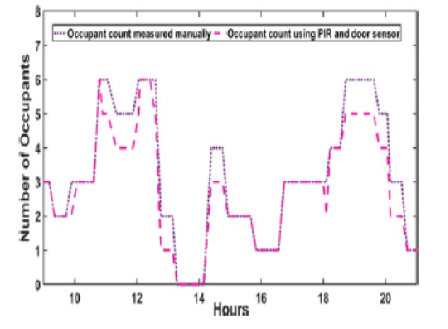


Indian Journal of Science and Technology
DOI: 10.17485/IJST/v17i26.1647
Year: 2024, Volume: 17, Issue: 26, Pages: 2683-2690
Original Article
R Lavanya1∗, N R Shanker2
1Department of Information Technology, Aalim Muhammed Salegh College of Engineering, Chennai, 600 055, Tamil Nadu, India
2Department of Computer Science and Engineering, Aalim Muhammed Salegh College of Engineering, Chennai, 600 055, Tamil Nadu, India
*Corresponding Author
Email: [email protected]
Received Date:14 May 2024, Accepted Date:10 June 2024, Published Date:28 June 2024
Objectives: The proposed Occupant Count Measurement (OCM) model aims to enhance sustainability, energy efficiency, comfort, and safety in smart buildings by accurately determining occupant count using thermal camera images and body temperature data. Methods: The model leverages real-time thermal camera images without the need for a pre-existing dataset. Key parameters include temperature threshold, occupant motion, size, and shape to ensure accurate occupancy estimation. The K-means algorithm identifies and clusters regions of interest (ROI) in thermal images corresponding to human body temperatures. The model also employs sensors like PIR, RGB cameras, and thermal image sensors. Manual counting serves as a benchmark for comparison. Findings: The K-means algorithm extracts regions with elevated temperatures related to human bodies from thermal images, partitioning them into K-clusters based on temperature ranges and assigning each pixel to one of the clusters. A temperature threshold differentiates human clusters in the thermal image, while connected component labeling refines human object segmentation by identifying blobs, which are then used for occupant counting. The model's precision is assessed using diverse image sensors and compared to the actual number of occupants. The proposed OCM model achieves an accuracy of about 90.2% compared to traditional methods. Novelty: This study introduces an OCM model that uses thermal images to estimate the number of occupants in a room based on their body temperature. The method focuses on detecting and counting occupants by their overall thermal body signature, providing a novel approach to occupant measurement in smart buildings.
Keywords: Thermal Images, Segmentation, Occupant Estimation, Occupant Comfort, Smart Building
© 2024 Lavanya & Shanker. This is an open-access article distributed under the terms of the Creative Commons Attribution License, which permits unrestricted use, distribution, and reproduction in any medium, provided the original author and source are credited. Published By Indian Society for Education and Environment (iSee)
Subscribe now for latest articles and news.